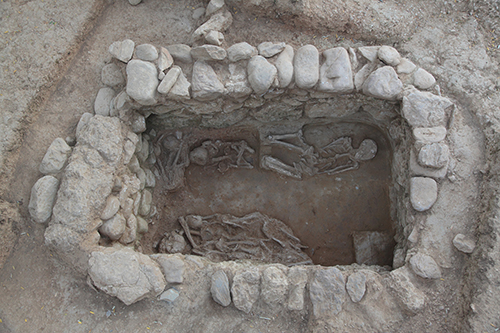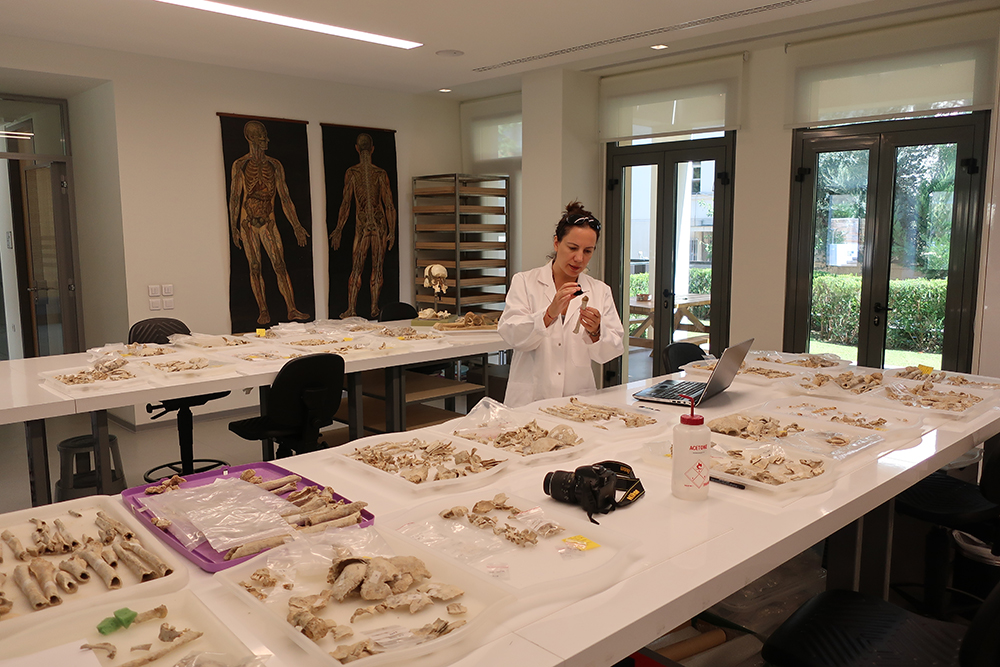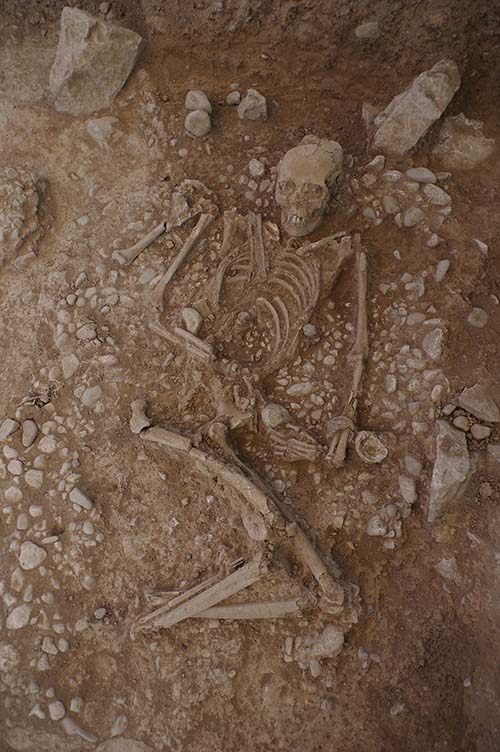Moutafi, Ioanna. "The Bioarchaeology of the Early Mycenaean period: An interdisciplinary study of human skeletal remains from Ayios Vasileios (Laconia) and Kirrha (Phokis)." CHS Research Bulletin 9 (2021). http://nrs.harvard.edu/urn-3:hlnc.essay:MoutafiI.The_Bioarchaeology_of_the_Early_Mycenaean_Period.2021.
Abstract
My research focuses on the social dimensions of Aegean mortuary practices, which I attempt to approach through a multidisciplinary bioarchaeological study of human remains in their archaeological context. This project, undertaken under the CHS Early Career Fellowship, focused on the transitional Early Mycenaean period (ca. 1700-1500 BC) and the investigation of key changes in mortuary treatment during these times. Two recently excavated Early Mycenaean cemeteries, Ayios Vasileios in Laconia and Kirrha in Phokis, comprised the case-studies of this project, allowing full integration of excavation and post-excavation data of all kinds, including stratigraphic, material, and biological information. By employing a novel bioarchaeological interdisciplinary methodology, the aim was to reconstruct funerary treatment to a new level of detail in order to assess its complex interaction with wider social practice, instrumental in the rise of the Mycenaean palatial societies.
Report
The question
The Early Mycenaean period, the onset of the Late Bronze Age in the Greek mainland, is of special interest to Aegean prehistory. It is a period of significant socio-political transformations, when the more austere, smaller, and rather “closed” Middle Helladic (MH) societies gave way to the expansionist Mycenaean polities, some of which will soon turn into the palatial centres of the Mycenaean world. These changes were paralleled by significant developments in the mortuary sphere and the introduction of novel funerary attitudes that eventually evolved into a widespread, rather standardised, funerary set in the palatial period. The distinctive change was the shift from the relatively homogeneous and rather simple MH single burials to the LH collective burials, eventually in new types of tombs. This new custom entails a complex funerary ritual of multiple stages, involving tomb re-use and a variable secondary treatment of the dead body. New discoveries make clear that these key developments were introduced in this transitional period. Therefore, our question is: what forms of mortuary treatment do we encounter in this period, and how are we to explain the increasing funerary diversity?

The methodological approach
The key to tackle this question is Social Bioarchaeology. Current theory perceives death as a social process, associated with a series of collective social acts (mortuary practices), which do not passively reflect reality but rather involve re-definition of identities, personhood, and social relationships. Therefore, by studying the full spectrum of mortuary practice we can reach an emic understanding of complex social processes in the past. In past research, however, the bones of the dead were left out of the core discussion; communication gaps between archaeologists and anthropologists hindered any holistic understanding. This is progressively changing, though. Surpassing traditional disciplinary boundaries, we can now explore new interdisciplinary ways to connect our theory, our methods, and our empirical data. With the dead body as the focus of funerary activities, my approach treats bones as the primary strand of evidence through a dual lens. Looking at bones both as subjects of their own lived experiences and as objects of the acts of the living at the time of death, we are able to unravel several dimensions of personal identities, social relationships, possible tensions, and shifts of emphasis. Employing a state-of-the-art, cross-disciplinary methodology developed during my previous research (see Moutafi 2021), centered on the taphonomic analysis of commingled skeletal remains, my aim was to reconstruct both a) the osteobiographies of the deceased (i.e. sex, age, stature, activities, health, diet) and b) the mortuary acts of the living, through the taphonomic analysis of funerary assemblages. To achieve the latter, methods of funerary taphonomy are employed, aiming at the reconstruction of formation processes, frequency/sequence of tomb use, and forms of disposal. These methods include refitting and individuation of commingled remains, the detailed estimation of Minimum Number of Individuals (MNI) per context, the analysis of preservation patterns and element frequencies, and the identification of anatomical articulations and spatial bone relationships. The contextual discussion of both aspects enables a much deeper understanding of funerary practices and their meanings.
The material
The recent excavations of the North cemetery of Ayios Vasileios (directed by Sofia Voutsaki, under the general directorship of A. Vasilogamvrou and the auspices of the Archaeological Society at Athens) and of the necropolis of Kirrha (directed by Raphaël Orgeolet, French School at Athens) offer an unprecedented opportunity to address funerary change in the Early Mycenaean period through this novel bioarchaeological approach. Both sites are of special significance to the understanding of social dynamics in this transitional period. Ayios Vasileios is a unique cemetery, associated with the formative phase of the site that later evolved into the palatial center of Mycenaean Laconia. Kirrha is rather different but equally interesting: the burial grounds extend over abandoned MH houses, illustrating the discourse between the past, present, and future in a shifting social landscape. The excavations, in which I was involved from the start as lead bioarchaeologist, were designed on an interdisciplinary basis to ensure maximum recovery of all contextual evidence (stratigraphic, geoarchaeological, cultural, and biological). Therefore, these sites provide unique funerary evidence through a variety of burial contexts (cists, pits, free-standing bone assemblages, and a few exceptional built tombs). The graves include complex funerary deposits, both primary and secondary, varying in form and numbers.

During the CHS fellowship
During the CHS Early Career Fellowship (2020-2021), skeletal material from both sites was studied at the M.H. Wiener Laboratory for Archaeological Science, American School of Classical Studies at Athens. Beyond the basic osteological recording of demographic, occupational, and palaeopathological evidence, the study focused on the taphonomic analysis of the bone assemblages in order to fully reconstruct details of the mortuary acts. The next step comprised the synthetic multi-dimensional analysis of various strands of data, through GIS-mapping and statistical analysis. Furthermore, the work was advanced in regards to the analysis of genetic and isotopic data from both sites, within the frame of our collaboration in the large-scale European project “Towards a New European Prehistory”, led by Professor K. Kristiansen (University of Gothenburg) and the expert teams of Professors E. Willerslev and K. Frei (University of Copenhagen). The goal of these advanced scientific analyses was to shed light on kinship, mobility, and diet. Finally, in consultation with the excavation directors and other members of our research teams (especially my colleagues, Frossini Vika and Anna Lagia, in the study of Ayios Vasileios and Kirrha respectively), we advanced towards the final theoretical interpretation of each particular case, and I attempted a first synthesis of the bioarchaeological results regarding the key research questions.
Research results
The key results regarding the reconstruction of mortuary acts are the following. Diverse and frequent acts of secondary treatment of the dead were attested in both sites. At the same time, the old “traditional” custom of single primary burials was also present. Diversity in secondary treatment was expressed in frequency, extent of skeletal involvement, and specific depositional choices. No significant gender or age differentiations in mortuary treatment were observed, with the exception of neonates and infants (up to three years of age) who seem almost entirely excluded from secondary treatment. A strong interest in associations between the secondary deposits to earlier burials was evident in both cases, and especially at Kirrha. Finally, the complexity of the mortuary treatment of the body does not seem to correlate with status-related characteristics, with the exception of very few individuals, like the distinct case of the “rich lady” of Kirrha.

Having now a much more nuanced picture of how the living treated their dead, we can get closer to the meaning of their choices. As already attested in Ayios Vasileios (Moutafi and Voutsaki 2016), the treatment of the body in that period appears to reflect fluid, permeable, and partible notions of the self. A shift from “closed” to more collective notions is evident. This is confirmed by new data and the results of the CHS project, both from and beyond Ayios Vasileios. It is clear that the people of these times need to stress and, at the same time, expand the bonds between their past, their present, and their future. In this process, the introduction and increasing intensification of secondary mortuary treatment is essential. The intensive mixing of body parts, ages, and sexes, the assembling of old and new dead together, and the re-associations allowed by selective relocations of the skeletal remains all point to the negation of separate identities and the creation of a new “whole”, stressing lineage and collectiveness. At the same time, within this nexus of shared mortuary spaces, tensions between individual and collective concerns are evident: some people prefer to stick to the older customs (e.g. single primary burials) and others prefer to single out specific individual(s) in the general mixing (e.g. single secondary deposits). The funerary ritual appears very flexible, allowing freedom for varying responses at death. Later on, tensions may soften or become more subtle as, to some extent, these practices will become consolidated and standardized in the palatial Mycenaean era. But the key characteristic of what is to come, the stressing of this collective identity that gets experienced and created through specific acts of funerary treatment, is already here and takes part in the creation of a “Mycenaean” future.
Dissemination
During this year, my book Towards a Social Bioarchaeology of the Mycenaean Period: a biocultural analysis of human remains from the Voudeni cemetery, Achaea, Greece (Oxford, Oxbow Books) got published. The book is not directly related to the Early Mycenaean period discussed here, but it describes in detail the methodology applied during my CHS project. My CHS project was presented in Kleos in October 2020, with a short article entitled: “The Bioarchaeology of the Early Mycenaean period: An interdisciplinary study of human skeletal remains from Ayios Vasileios (Laconia) and Kirrha (Phokis)”. Most importantly, results relevant to this project are discussed in the following papers in peer-reviewed journals and edited volumes, published in 2021 or currently in press:
- Frank, A.B., R. Frei, I. Moutafi, S. Voutsaki, R. Orgeolet, K. Kristiansen, and K.M. Frei. 2021. “The geographic distribution of bioavailable strontium isotopes in Greece – a base for provenance studies in archaeology.” Science of the Total Environment 791.
- Voutsaki, S., V. Hachtmann, and I. Moutafi. 2021. “Space, place and social structure in the North Cemetery, Ayios Vasileios”. In (Social) Place and Space in Early Mycenaean Greece, International Discussions in Mycenaean Archaeology, October 5–8, 2016 in Athens, ed. B. Eder and M. Zavadil, 323–340. Vienna.
- Voutsaki, S., I. Moutafi, and V. Hachtmann. In press. “The North Cemetery at Ayios Vasileios. Austerity and differentiation in the Early Mycenaean period.” In Proceedings of the international conference ‘Middle and Late Laconia. Competing Prinicipalities?’ (Athens, 12-13 April 2019), ed. C. Wiersma and M. Tsouli. Leiden.
Also, a paper for EAA 2021 Annual meeting at Kiel entitled “One is not enough, it’s Tomb 21: Taphonomy and change in the Early Mycenaean Ayios Vasileios North Cemetery, Greece” has been accepted, and it is going to be presented conjointly with S. Voutsaki on September 9, 2021.
Finally, aspects of this project were presented in invited seminars for undergraduate students of the University College Dublin (02/2021) and University of Ioannina (12/2020).
Selected Bibliography
Boyd, M.J. 2016. “Becoming Mycenaean? The Living, the Dead, and the Ancestors in the Transformation of Society in Second Millennium BC Southern Greece.” In Death Rituals, Social Order and the Archaeology of Immortality in the Ancient World: ‘Death Shall Have No Dominion’, ed. C. Renfrew, M.J. Boyd, and I. Morley, 200-220. Cambridge.
Cavanagh, W.G., and C. Mee. 1998. A private place: death in prehistoric Greece (Studies in Mediterranean Archaeology CXXV). Jonsered.
Gowland, R., and C. Knüsel, eds. 2006. Social Archaeology of Funerary Remains. Oxford.
Knüsel, C.J., and J. Robb. 2016. “Funerary taphonomy: An overview of goals and methods.” Journal of Archaeological Science Reports 10:655-673.
Lagia, A., I. Moutafi, R. Orgeolet, D. Skorda, and J. Zurbach. 2016. “Revisiting the Tomb: Mortuary Practices in Habitation Areas in the Transition to the Late Bronze Age at Kirrha, Phocis.” In Staging Death: Funerary Performance, Architecture and Landscape in the Aegean, ed. A. Dakouri-Hild and M.J. Boyd, 181-206. Berlin.
Moutafi, I. 2021. Towards a Social Bioarchaeology of the Mycenaean Period: a biocultural analysis of human remains from the Voudeni cemetery, Achaea, Greece. Oxford.
Moutafi, I., and S. Voutsaki. 2016. “Commingled Burials and Shifting Notions of the Self at the onset of the Mycenaean Era (1700-1500 BC): The Case of the Ayios Vasilios North Cemetery, Laconia.” Journal of Archaeological Science Reports 10:780-790.
Robb, J. 2013. “Creating death: an archaeology of dying.” In The Oxford Handbook of the Archaeology of Death & Burial, ed. S. Tarlow and L. Nillsson Stutz, 441-457. Oxford.
Voutsaki, S. 2010. “Agency and personhood at the onset of the Mycenaean period.” Archaeological Dialogues 17(1):65–92.
